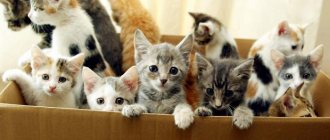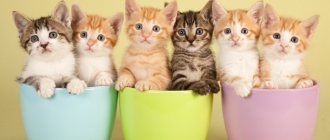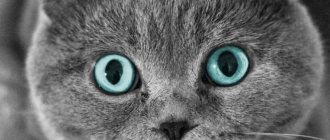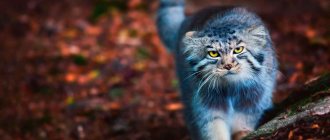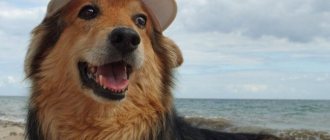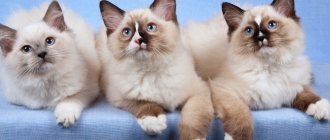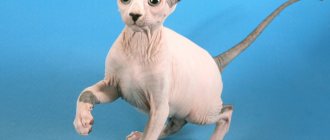Sometimes a furry pet doesn’t come into your home from a well-known nursery. And the owner has a logical question: a purebred animal or “nobleman” has become a new tenant and family member.
There are few ways to determine a cat's breed. They are all quite relative. Only an experienced felinologist can give a final verdict.
Yorkshire cat
A table that will help you determine the cat breed
| Breed | Photo |
| American (including those that appeared or were bred in the USA) | |
| American Wirehair | |
| American Shorthair | |
| American Curl | |
| American Ringtail | |
| Bombay | |
| York chocolate | |
| Maine Coon | |
| Ojos Azules | |
| Ragamuffin (from Ragdolls) | |
| Ragdoll | |
| Asian | |
| Asian tabby | |
| Asian Tiffany | |
| British and Scottish | |
| British Longhair | |
| British Shorthair | |
| British chinchilla | |
| Scottish Fold (Scottish Fold) | |
| Scottish Straight (Scottish Straight) | |
| Scottish Fold Longhair (Highland Fold) | |
| Bobtails (no tail or short) | |
| American Bobtail | |
| Karelian Bobtail | |
| Kymri (Kymrik, semi-long-haired species of Manx) | |
| Kurilian Bobtail | |
| Mekong Bobtail | |
| Manx (Manx) | |
| Pixiebob | |
| Skif tai dong | |
| Japanese Bobtail | |
| Hybrids | |
| Bengal (from Asian leopard cat) | |
| Bristol (from the wild long-tailed cat Margay, they were similar to Bengals, but now breeding work has stopped, there are no more cats) | |
| Karaket (from Karakal) | |
| Savannah (asherah) (from Serval) | |
| Safari (from Geoffroy) | |
| Serengeti (from Bengal cat) | |
| Toyger (breeding work with Bengal) | |
| Chausie (from Jungle Cat) | |
| Naked | |
| Bambino | |
| Dwelf (from Munchkin, Sphinx and Curl) | |
| Don Sphynx | |
| Canadian Sphynx | |
| Minskin (from Munchkin and Sphinx) | |
| Petersburg Sphinx (Peterbald) | |
| Ukrainian Levkoy | |
| Elf (from the Canadian Sphynx and Curl) | |
| With Siamese point color | |
| Balinese or Balinese (Balinese) | |
| Burmese | |
| Himalayan (similar to Persian, long-haired) | |
| Neva Masquerade | |
| Siamese | |
| Snow-shoe | |
| Thai | |
| Tonkinese (hybrid of Thai and Burmese) | |
| Short-legged | |
| Munchkin | |
| With blue color | |
| Korat | |
| Nibelung | |
| Russian blue | |
| Rex (with curly hair) | |
| Devon Rex | |
| Hermann rex | |
| Cornish Rex | |
| Laperm | |
| Selkirk Rex | |
| Ural rex | |
| Flat faced Persian | |
| Napoleon (minuet) | |
| Persian | |
| Exotic Shorthair | |
| Oriental view | |
| Javanese | |
| Oriental | |
| Foreign White | |
| Other shorthairs | |
| Abyssinian cat | |
| Australian Mist (Australian Smoke) | |
| Anatolian cat | |
| Arabian Mau | |
| Brazilian | |
| Burmanskaya | |
| Burmilla (a hybrid of Burmese and Persian) | |
| Havana | |
| European Shorthair | |
| Egyptian Mau | |
| Kanaani | |
| Khao-mani | |
| Carthusian (Chartreuse) | |
| Lykoi | |
| Ocicat | |
| Sokoke | |
| Aegean | |
| Other longhairs and semi-longhairs | |
| Norwegian forest | |
| Siberian | |
| Somali (from Abyssinian) | |
| Turkish Angora | |
| Turkish van | |
Advice on how to prove a cat's pedigree
If your cat does not have a “passport” (pedigree metric), this does not mean that he is not purebred. Let's say you have studied all the characteristics and photographs and found that your pet fully meets the requirements. If you wish, you can contact the nearest nursery that specializes in breeding a specific breed and ask professional felinologists to study the cat (). If the experts do not find any reason for rejection, then you will be given a document with the pedigree of the first generation. It gives the right to participate in exhibitions (though in special categories where similar “pioneers” of their breed are presented).
An example of what a pedigree metric looks like for a Siberian cat
All breeds have strict requirements for appearance and character. By comparing the standards and finding full compliance with the characteristics of your cat, you can make an assumption about the pedigree of the four-legged pet. This is sufficient to assign the status “phenotypically similar to (name).” There is even a chance to get a pedigree metric of the first generation - a document confirming the pedigree of cats with unknown parents.
Methods for determining cat breed
Here are the main points that will help determine the breed if the table above does not cope with this:
- Mutation signs and features. More often it is the shape and size of the ears - for example, curled back in Curls or drooping in Scottish Folds. Tassels on the tips are also a characteristic feature (Caracat, Maine Coon). The short length of Munchkin's limbs, fixed by a mutation gene, also makes him easily recognizable.
- The color of the iris, their shape and location. Some lines have only one eye color (blue - Siamese, green - Nibelungs) or multi-colored, like the Turkish Van. Asian cats, in addition, have a characteristic oriental cut, often with a slight braid.
- Head shape and coat color. There are varieties that you will never confuse with anyone else due to the peculiar structure of the skull. For example, in Oriental it is narrow and elongated, while in Exot it is almost rectangular with rounded edges and an original flattened nose. The wild spotted color of the Bengal differs significantly from the pattern of the color-point Siamese.
- Body type and coat quality. Bengals, Toygers, and some other breeds are characterized by a strong, muscular and agile body. Orientals, Thais and Sphinxes have an elegant, sophisticated physique. American Shorthair, bobtails are stocky, powerful, and heavy in appearance. The type of coat differs significantly between longhaired, semi-longhaired, short-haired and hairless cats.
- The animal's temperament is also a feature of the breed. On this basis, the lively and restless Abyssinians can never be confused with the phlegmatic Briton.
kisapes.ru - site for identifying the type of cat
Kisapes is an information resource dedicated to cats and dogs. There you can find a lot of useful information, read articles about what breeds there are, find out which ones are most often compared with each other, and also find out the breed.
- Go to the website https://kisapes.ru/ and click on the three stripes in the upper right corner.
- A side menu with several sections will open in front of you; select “Identify breed by photo.”
- Here you need to either upload a photo from your device or paste a link to the photo.
- In a few seconds you will be able to find out the result.
The service promises that all photos you upload are stored on their server for no more than half an hour, and then deleted.
Why determine the breed and when is it necessary?
It may be necessary to determine the breed of a cat if:
- The pet was purchased from unknown persons, without documents, and it must be registered at a veterinary clinic or felinological club.
- Mating with a purebred male (female) is planned.
- A cat found on the street or abandoned needs to be given an accurate diagnosis, which may be related to hereditary or specific diseases.
- A pet is beautiful and unusual and many people want to have the same one, or a photo with a cat has made them want to have an animal of this type.
To register a furry friend in the association of felinologists, it is necessary to have a pedigree or birth certificate - birth documents that indicate both parents with their document numbers and titles.
Javanese Burma
Both must be certified by a seal and contain information about the club and nursery. Even if an animal is born from a titled pair of the most expensive cats, without official paper it will be considered outbred.
In order to spend less money when purchasing an animal, many people buy it as a pet-class pet, that is, as a pet, since the price in this case is significantly lower. After which, by any means, even turning to scammers, they try to make a pedigree. This is a big mistake. All purebred individuals are registered in the electronic felinological database. The deception will definitely be revealed and the animal will be disqualified.
If the owner plans to engage in breeding or participate in exhibitions with the cat, you should not save when purchasing.
Breed class (animal for breeding) and show class (exhibition) do not have the right to be outbred. Therefore, if a furry pet with a pedigree is offered a mating with an animal, even clearly an “aristocrat”, but without documents, you should refuse. Otherwise, you need to understand that the offspring born will not be considered purebred.
In the veterinary passport, the name of the breed is quite arbitrary; the entry is made there according to the words of the owner and cannot be a document confirming the origin of the individual.
If a cat is found on the street, then, first of all, it should be taken to a veterinarian to identify diseases and undergo vaccination.
It is not worth using such an individual to produce offspring, even if the tramp looks like, for example, a handsome Bengal. It is unlikely that a purebred animal will end up on the street. And it’s impossible to make a pedigree for him.
Ocicat Snow Shoe
Siberian cat
But if your pet has obvious health problems, then it is advisable to find out whether it belongs to a certain type. Some feline “aristocrats” are characterized by characteristic diseases. Diagnosis can be greatly simplified.
It is possible to determine the breed from a digitized photograph by doing a “picture search” on the Internet. Or if there are characteristic features - a short tail, characteristic ears, fur and color - formulate a description task in a search engine.
The best method is to contact a felinologist, for example, by visiting a cat show.
Traits associated with genetics
There is such a thing as sex-linked inheritance of traits. Thus, individuals with a three-color coat color will definitely be female, since the simultaneous presence of bright red, white and black colors guarantees the presence of two X chromosomes. (XX – female, XY – male). A genetic pathology (triploid set of sex chromosomes XXY) occurs very rarely, when cats have this coat color, but they cannot have offspring. Also, calico and tortoiseshell colors belong only to cats.
There are obvious differences by sex in mature animals during the period of sexual heat, which, as a rule, occurs no earlier than 7 months:
- Cats begin to more actively mark the surrounding territory, filling your home with a specific smell, become anxious, noisy, and try to go outside.
- Cats make heart-rending sounds day and night, fawn over others, roll on the floor, and arch their backs.
The main differences between purebred and outbred pets based on various factors
Any cat is unique and inimitable, regardless of whether it has a purebred document or not. But there are still some differences.
Each breed officially registered in the felinological system has a standard - a detailed description of its appearance: size, proportions of the body and limbs, color and length of coat, eye shape, ear position and other data. Even the standard character of an individual is usually described there.
Photos will be provided, from which it is quite easy to determine whether the pet belongs to this line.
The most characteristic colors for some varieties:
- A kind of “mask” on the face, paws and tail of the same color, darker than the main tone - Siamese, Neva Masquerade, Thai breeds.
- Blue coat color with a silver haze - Russian Blue or Nibelung.
- Color with a “leopard” spot or “rosette” - Bengal, Savannah, Ocicat, some other lines with a “tabby” color.
- Ticked reddish coat in the Abyssinian and Somali.
- Toyger has brindle coloring - pronounced black stripes on short fur.
- All varieties of Rex have wavy or curly fur.
- The paws end in white “socks” in the Snowshoe or Sacred Burma.
Maine Coon Wild Caracal with tassels Manx without tail
You can also determine the pet's identity by the type of fur:
- All Sphinxes have no fur at all: Canadian, Don, St. Petersburg.
- The coat of the Cornish Rex and Devon Rex is short and wavy.
- Selikt rexes have long and curly hair.
- Short and stiff, but at the same time having ringlets, the coat belongs to the American Wirehair or Curly Hair cat.
- Long, thick and fluff-like fur is characteristic of the Persian cat and the Turkish Angora.
British chinchilla Sphynxes Persian cat
According to anatomical features:
- Tassels on the ears - Maine Coon, Pixie Bob, Caracat, Siberian cat.
- The tips of the soft ears “hanging” forward are found in Scottish Folds.
- Curled ears make any Curl recognizable.
- Bright blue or blue eyes - in Siamese cats, Mekong Bobtail, Sacred Burma, Turkish Angora, Ragdoll, Javanese.
- Nibelung and Russian Blue have emerald eyes.
- Multi-colored eyes (such as blue-green or blue-yellow) are often found in the Khao Mani, Turkish Angora, and Turkish Van.
- Tailless cats - Kurilian, American bobtail, Pixie-Bob.
- The Mekong Bobtail has a short tail with kinks and bends.
- The tail is wrapped in a ring, like a Siberian husky, only in one breed - the Ringtail or Ring-tailed cat.
- Short legs - Munchkin.
- Siamese and Oriental cats have an elongated, rather narrow muzzle and large ears.
- Very large, but at the same time graceful, short-haired and similar to a wild cat - Savannah, Caracat, Chausie.
- Large, massive, heavy in appearance, with long hair - Maine Coon, Siberian, Norwegian Forest.
Norwegian Forest Cat Balinese Cat Japanese Bobtail Munchkin Oriental
Does your cat have external differences from ordinary cats?
How to recognize a cat's breed by external features?
Most outbred cats correspond to one gold standard: medium-sized paws, medium-wide chest and rump, and a rounded head, crowning this standard splendor.
But we're talking about exceptions, right? So, what exceptional external characteristics bring a simple cat closer to a purebred cat?
Ears
- American Curl. These are the only cats in the world whose ears are folded back. The bend can reach 180 degrees.
- Ukrainian Levkoy. A hairless or slightly fluffy Levkoy is different... Yes, in fact, this breed is different from everyone else. You can recognize it by its ears, which are literally curled up in Levkoys.
- Scottish lop-eared. Sometimes it seems that Scots don’t have ears, but in fact the problem is in the cartilage, which is so deformed that the pinna seems folded in half. The degree of bending varies from barely noticeable to almost complete fit to the head.
- Elf Kat. Americans Karen Nelson and Kristen Leedom bred a breed with wonderful ears. Indeed, it is impossible not to notice a cat with such huge patterned ears.
- The poodlecat is an exotic and artificially bred breed. Fold-eared representatives of the breed have ears that do not lie close to the head, and it is believed that the more beautiful the poodle cat is, the larger its floppy ears.
Short tail
Cats whose tail is in its infancy (or even none at all) are worth a lot. Unlike artificial docking in dogs, a cat's short tail is a purebred sign:
- Cymrik is a breed without a tail at all. From the word absolutely. At the same time, Cymrics have short front legs and a peculiar jumping gait.
- Manx are another tailless purr. True, not all of them - according to the standard, Manxes either have no tail at all or show off with a very long one.
- Pixiebob is a mini-lynx that was bred in the 80s of the 20th century. The tail of domestic predators can sometimes be two centimeters long, and sometimes even 15 cm.
- The Kurilian Bobtail is a breed in which the genes of the Japanese Bobtail and Siberian cat are mixed, bred in Russia.
- The American Bobtail demonstrates its temperament with its tail, which reaches the base of its hind legs.
- The Japanese Bobtail is a classic representative of cats with short tails. According to the standard, the tail of a Japanese bobtail should, firstly, be no longer than 12 centimeters, and secondly, the tail must be curled.
Little paws
When breeders began to breed cat breeds with short legs one after another, fears arose that in the future such pussies would have problems with mobility or the spine. But time has shown that these suspicions are unfounded, since short legs are compensated by greater flexibility of the spine.
Are your cat's paws significantly shorter than your neighbor's paws? There are several breeds for you to choose from, most of which you have already met above.
- Skookum - the dwarf La Perm has a long and wavy coat. Another feature of the breed is its pronounced collar. By the way, the breed was originally called poco chino (Small Curly).
- Dwelf - without hair, without long legs.
- Munchkin
- Napoleon
- Minskin
- Bambino
Breed classification
Felinology is a science that studies the anatomy and physiology of cats, their reproduction and selection. There are many systems for recording and assessing animals in this area. For the most part, they come down to two groups - American and European.
At cat shows, without exception, everyone is judged by genotype. Family affiliation and origin are determined by the pedigree - the main cat document, which, in fact, reflects the family tree of the pet, at least up to the fourth generation. In addition to the names of the ancestors, all colors and dates of birth, the names of the nurseries where the animals came from are indicated.
The data of the club and the association itself are necessarily recorded in the “header” of the document.
Each pedigree has its own number, by which it can be easily found in the electronic accounting system. Colors are designated by specially adopted codes.
Such a document not only indicates the pet’s ancestral affiliation, but also allows you to determine which genes it is a carrier of, and what kittens it may have.
Only the oldest American system, TICA, as the most democratic, allows assessment by phenotype - the appearance of the animal.
In this system, all individuals are divided into six categories:
- Category I - Established Breeds - lines formed as a result of selection.
- Category II - Natural Breeds - natural breeds.
- Category III Variant or Mutation Breeds - the result of genetic mutations.
- Category IV - Domestic Hybrid Breeds - interbreeding.
- Category V - Non-Domestics Source Breed Hybrids - crossing of domestic and wild animals.
- Category VI - Experimental Breeds - experimental breeds.
The cat's status code is indicated by a set of Latin letters and numbers (date of birth and personal number).
If the alphabetic code SB is written in the pedigree, such a pet is a full-fledged representative of one of the recognized breeds. Its designation and the name of the animal (usually includes the nursery's own name) are written in the first line.
There are four categories in the European WCF system. Cats are divided according to the type of cover:
- Category I - Shorthair I - animals with short hair, group 1 - includes Orientals, Siamese and Thais, Peterbald and Tonkinese cats.
- Category II - Shorthair II - animals with short hair, group 2 - all other shorthaired animals.
- III category - Semi-Longhair - semi-longhaired cats - Siberian, Maine Coons, Norwegian Forest, Nibelung, others.
- Category IV - Longhair - long-haired group - Persian only.
In this system, the pedigree number encrypts: breed, category, color and sex of the animal. A cat from the experimental group or an unrecognized variety will not be issued a document in this system.
Pedigrees of other systems are not very common in Russia. But if you need to decrypt them, you should contact the club that issued it.
Information about him and the feline system, indicating telephone numbers and addresses, is required in the document of any association.
Singapura Siberian cat
Determining gender by external characteristics
Another way to distinguish a cat from a cat is to carefully look at the face and body of the animal.
However, this method is suitable for avid cat lovers.
A person who determines the sex of a cat for the first time is unlikely to be able to do this accurately.
A cat differs from a cat in the following ways:
- You can determine the sex of a cat by its face and nose. They are quite wide;
- he has a powerful and large physique;
- paws are thick;
- A castrated cat can be distinguished from a female cat by its large head and thick skin.
External signs of a cat:
- has a more graceful body, graceful curves. This is especially noticeable in short-haired breeds like the Oriental, Savannah and Cornish Rex;
- if you try to find out the gender by the muzzle, then you need to look at its elongation: in cats it is more elongated in length rather than in width.
This can be seen in the photograph: the muzzle is narrow and elongated.
Gracefulness is the main characteristic of a cat
Another external sign of how to distinguish a cat from a cat is color:
- If a kitten at birth has a tricolor or tortoiseshell coloration, then we can say with complete confidence that it is a cat. This is due to a genetic feature. For the appearance of black, white and red colors in the coat, two X chromosomes are needed. And only females have them. A cat can only develop this color in the case of a genetic disease, which is quite rare.
- The color Calico also belongs to cats;
- Only cats are red or cinnamon colored.
You can sometimes accurately determine a cat's gender by coat color.
Mr. Cat recommends: Online locator
Today, in the age of the ubiquitous Internet, to determine or clarify the breed of a pet, you can turn to “online identifiers”.
These virtual assistants are tables that systematize the breed characteristics of a wide variety of cat representatives. Simply by answering the questions posed using logical chains, you can determine whether the animal is purebred and which group it belongs to.
It should be remembered that these determiners are not an official expert; according to their estimates, it is impossible to obtain a pedigree for a cat. They cannot give a 100% guarantee that the result will be correct.
In this case, it is advisable to evaluate an adult animal; it is impossible to test a newborn here. The kitten needs to mature for at least six months in order for its breed characteristics to appear.
The test is not for weaklings: guess the cat from the photo!
Do you consider yourself a real connoisseur of cat breeds? Prove it to yourself and your friends by sharing your test result!
Write a comment!
I was sure that I understood cats much better! But the test made me tense up
I didn't expect this from myself. It seems like a small thing, but it’s nice.
6 out of 17 I’ll probably go into dog breeding
17 of 17 ... But I still love dogs more, sorry, funny fluffies who are already hungry at five in the morning, and are ready for breakfast at seven in the morning
Surprised. I am a cat lover. I leafed through one book about cats to guess who could become the father of my cat, because... her blue British mother gave birth to 5 completely black kittens. I made a mistake 2 times.
7 out of 17. I thought that I understood cats better - it turns out that I still have to study and study.
Features of pedigree kittens
Determining the breed of a kitten by phenotype is not always within the power of a professional. Some have such obvious natural features that they cannot be confused with anyone else; in this case, the table at the beginning of the article will help. Others differ so little from each other that they require the help of an experienced felinologist, supported by a genetic test.
Selkirk Rex Balinese
Signs of thoroughbredness and obtaining a pedigree are important for those cases when the pet is awaiting breeding work or an exhibition career.
It must be remembered that the upbringing, love and appreciation of a cat is not determined by the “purity” of its blood.
1111
Caution when handling kittens
When examining babies, you need to be as careful as possible. The kittens' bodies are not yet strong enough, so even an accidental awkward movement or slight use of force can injure the pet.
Photo: you need to be careful when examining kittens
It is very important to consider the age of the kitten. Newborn babies should not be separated from their mother until they reach one month of age.
You need to lift the kittens carefully by the scruff of the neck (in no case by the tail!), holding it lightly. Try not to hold the baby in your arms for more than two minutes, otherwise his mother will be very worried
Determining the sex of a kitten is not as difficult as it might seem at first glance. With just a little practice, you will be able to distinguish a boy from a girl even by the outline of his face.
Main distinguishing features
Externally, cats have more or less the same appearance. These animals have a rump and chest of medium width, and the head is rounded. In members of different species, certain aspects of their appearance acquire certain functions through reproduction. Belong to them:
- body size;
- Ear water structure (unusual shape, deformed cartilage, curled, etc.)
- Limbs (short, normal, elongated)
- fur;
- hair color.
Based on these parameters, you can indicate whether the animal belongs to a certain species. Let's look at them in more detail.
Body size and structure
The length of the average domestic cat is up to 75 cm. Their tail is about 30 cm long. Standard males weigh 4 and 6 kg and females 2.3 - 4.5 kg. Some breeds weigh much more, their body weight can reach 20 kg.
The largest races include:
- American Bobtail;
- Smoked Bobtail;
- Maine Coon;
- British cat;
- Norwegian Forest Cat;
- Ragdoll;
- Pixiebob;
- savannah;
- Turkish cat vans;
- Siberian;
- Chartreuse.
There are also small species that weigh no more than 2.5 kg. These include Bambino, Napoleon, Dulf, Kinkalova, Lantzkin, Minskin, Skif Tai-Donu, etc.
Paws
Most cats have limbs of medium length. However, many purebred animals have short legs. According to this feature, you can easily distinguish blue bloods from ordinary backyard animals. These short-earth legs are Napoleon, Minice, Dwefy, Skooki, Bambino and Munchkins. Small paws are compensated by the mobility of the spine. This spine will help you move easily with short limbs.
Tail
Cats usually have a long tail. However, some varieties have a short tail, which is a congenital trait and not a consequence of surgery. Pedigree animals can be easily recognized by this seal. However, you should check whether the short tail is not the result of injury. Breeds that have unusual tails include:
- A cat without a tail and short forelimbs. For this reason, it has a boot walk;
- The tail is only 2 and 15 cm long;
- Animals without a tail or with a very long tail;
- American Bobtail tail length no longer than the base of the hind legs;
- Japanese bobtail about 12 cm long;
- Kurilian Bobtail.
Even the rarest races can be easily recognized after building the tail.
Ear shape
Non-studded animals have a typical mustard design. With aristocrats, the ears often have an unusual appearance:
- Tilt up to 180 degrees; American curl;
- with deformed cartilage, which collects mustard up to half; Scottish spotted cat;
- Curly; from representatives of Ukrainian diversity LWIE CAT;
- Patterned and large in size; Elf cat.
Other aristocratic races will have ears similar to one of the types described above.
Coat type and color
The definition of a purebred animal is always based on the Ukan and its coloring. All aristocratic varieties have their own characteristic hair cap colors.
Breeds differ in hair length. For short-haired varieties include: Tonkiy, Siamese, Abyssian, Singaporean, Cork, Bombardier. Maine Coon, Simrak, Persian, Balinese and Ragdoll Wu Long hair. There are also hairless species, the Ukrainian lion and the sphinx.
Curly short hair is found in almost all varieties of Rex: Germanic, Devonian and Cornish cats. Long-haired curly breeds are Behema and Selirk Rex. American Shorthair breeds have a coarse coat with bouncy curls.
It is necessary to understand that the presence of an unusual color in a street kitten already indicates the presence of aristocratic relatives.
Varieties such as the Thai, Nevsky, Balinese and Siamese have dark paws, muzzle and tail. The Ragdoll, Burmese and Snow Show members all have white socks and a black tail, paws and mouth area.
Russian Blue, British and Nibelung are distinguished by their smoky gray or blue color. Abyssinians and Somalis have a sandy color. Bengals, Egyptian Mau, Safari and Savannah cats have bright stripes and spots. Havana, Brown or Tiffany-Chantilly have brown fur.
Mestizos can have characteristics of several races at the same time. This is a common occurrence when species mix. Despite the differences noted above, only a breeder or veterinarian can accurately determine the breed.
Using the above parameters, you can approximately determine whether we have a purebred cat or not. No matter what type of cat it is, it needs a balanced diet, good and proper care and love from you.
Which cat is purebred?
A cat is considered purebred if it has a number of characteristics (genotypic and phenotypic) that correspond to a certain group of animals artificially bred by humans over several years.
A purebred animal has a pedigree that indicates 4–5 generations of relatives. The document is issued by a felinological club or system. That is, having a similar exterior is not enough to reliably identify the breed. A document confirming the breed is required (usually a pedigree) officially certified by a club or felinological system.
In order to professionally engage in breeding work, exhibit a cat at exhibitions and receive high marks, it makes sense to immediately purchase an animal from a trusted club or nursery with a confirmed pedigree. In all other cases, the pet will be considered outbred. Because otherwise it is impossible to check how “pure” a cat is by breed.
According to body size
The domestic cat or female cat grows to a small size. On average, their body length ranges from 70 to 75 cm. The size of the tail of a domestic cat is slightly less than half of the body - 30 cm. The body weight of adult cats ranges from 4-6 kg, while the weight of cats starts from 2.3 and does not exceed 4.5 kg.
If you, as an owner, suddenly notice that an adult cat is too small for its age or its size is large, then you should doubt its outbredness. The breed is not determined correctly based on one trait, so you need to carefully study additional parameters.
If your cat is too large, then perhaps he is a representative of one of the oldest breeds:
- Norwegian forest cat, males of which can reach 10 kg in weight.
- Pixiebob is a cat similar to a wild lynx, artificially bred in America. Female pixie bobs gain no more than 5 kg, while males of this breed have a body weight close to 10 kg.
- Siberian cat. Females of this breed do not exceed 6 kg, males - 12 kg.
- Maine Coon. An adult cat of this breed has a maximum weight of 8 -8.2 kg, a female cat - 5.4.
- Chartreuse is a cat nicknamed cat-dog. The maximum weight for adult cats ranges from 6-7 kg, for female cats - 4-5 kg.
To this list you can add the American and Kurilian bobtail, British cat, savannah and ragdoll.
If a domestic cat has reached adulthood and is far from normal in size, it may be a member of a certain breed. Usually a purebred cat is one whose weight does not exceed 3 kg.
The smallest cat in the world is a munchkin breed with the nickname Tiny Cat. An adult cat belonging to this breed does not outgrow 15 cm in length.
© shutterstock
To determine a breed by size, it is important not to lose sight of other details, because some breeds have the same weight, but differ in coat color.
that cats and domestic cats were once a steppe cat (and purebred cats - such a cat should belong to a cat (this includes a cat, even fold-eared cats, but a Siamese cat, an Abyssinian cat, cats, cats and features of color and eyes, coat color, main color) dense, corresponding to the color, short-haired, color options, Nosiamese color with
muzzledogfaceread more
Sizing
When answering the question of how to find out the breed of your cat by size, take into account that most ordinary domestic cats have a body length ranging from 50 to 75 cm. The length of the tail usually does not exceed 30 cm, and the weight is 4-6 kg in cats and 2−4.5 kg in cats. However, sometimes the breed characteristics of animals are manifested in the increased dimensions of their bodies. This sign helps determine the pet’s breed.
Thus, the largest species of animals include:
- Kuril Bobtail (domestic breed bred on the Far Eastern islands of Iturup and Kunashir);
- pixie bob (an artificially bred species in the USA, the representatives of which resemble the red lynx in appearance);
- Turkish Van (one of the most ancient breeds on Earth);
- American Bobtail (bred from wild cats in North America);
- Chartreux (French breed, known in its homeland as “dog-cat”);
- forest Norwegian (the body weight of males of this species can reach 10 kg);
- British;
- Maine Coon;
- Siberian;
- ragdoll;
- savannah.
There are breeds of cats whose weight is less than that of most domestic animals. The most common of them:
- Munchkin (a breed that was often involved in crossbreeding to develop new varieties);
- bambino (the result of crossing a munchkin and Canadian hairless sphinxes, whose weight does not exceed 2.5 kg);
- skookum (obtained from a cross between munchkins and laperms, have wavy long fur);
- Singaporean (bred in Singapore, then exported to the USA and Europe);
- kinkalow (the rarest type of cat, representatives of which weigh about 1.3 kg);
- Napoleon (the result of crossing Persian cats and munchkins, weighs about 2.5 kg);
- lambkin (animals with curly hair, like lambs, weigh about 1.8 kg as adults);
- Dwelf (a breed of animals without hair, obtained as a result of crossing Munchkins, American Curls and Canadian Sphynxes, weighs about 3 kg);
- Minskin (small and light cats without hair);
- Scythian-tay-don (the smallest cats in the world, better known as “toybob”).
